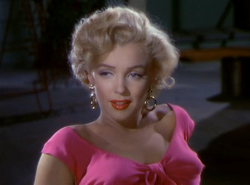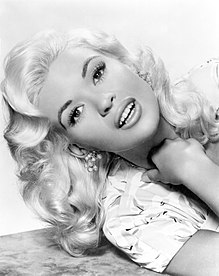Blonde stereotype

Blonde stereotypes are stereotypes of blonde-haired people. Sub-types of this stereotype include the "blonde bombshell" and the "dumb blonde". Blondes have been stereotyped as less intelligent than brunettes. There are many blonde jokes made on these premises. However, research has shown that blonde women are not less intelligent than women with other hair colors.[1][2]
The blonde bombshell is one of the most notable and consistently popular female character types in cinema.[3] Many showbiz stars have used it to their advantage, including Jean Harlow, Marlene Dietrich, Marilyn Monroe, Jayne Mansfield, Brigitte Bardot and Mamie Van Doren.[4]
Background
There are several aspects to the stereotypical perception of blonde-haired women.[5]
In contemporary popular culture, it is often stereotyped that men find blonde women more
On the other hand, a blonde woman is often perceived as making little use of
Typology

Annette Kuhn divides blonde stereotypes in cinema into three categories in The Women's Companion to International Film:[15]
- The "ice-cold blonde": Kuhn defined it as "a blonde who hides a fire beneath an exterior of coldness". She provided Grace Kelly as an example. English actress Madeleine Carroll originated the role in Alfred Hitchcock's The 39 Steps (1935), with Kelly among those who would follow her.[16]
- The "blonde bombshell": Kuhn defined it as "a blonde with explosive sexuality and is available to men at a price". She provided Brigitte Bardot, Lana Turner, Jean Harlow, Joan Blondell, Mae West, Barbara Eden, Marilyn Monroe, and Diana Dors as examples.
- The "dumb blonde": Kuhn defined it as "a blonde with an overt and natural sexuality and a profound manifestation of ignorance". She provided Jayne Mansfield, Marion Davies, Alice White, Marie Wilson, and Mamie Van Doren as examples.
In
Blonde bombshell

The blonde bombshell is a
Dumb blonde

The notion of "dumb blonde" has been a topic of academic research reported in scholarly articles and university symposia, which tend to confirm that many people hold to the perception that light-haired women are less intelligent than women with dark hair.[10] It is believed the first recorded "dumb blonde" was an 18th-century blonde French courtesan named Rosalie Duthé whose reputation of being beautiful and dumb, even in the literal sense of not talking much, inspired a play about her called Les Curiosités de la Foire (Paris 1775).[6]
While there is no evidence that suggests that blondes are less intelligent than other people, it has been suggested earlier that the state of being blonde probably creates opportunities that do not require investing in education and training. A possible earlier hypothetical explanation is that physically attractive women have less pressing incentives to cultivate and demonstrate their intellect to ensure their future, since physically attractiveness is an asset, or correlatively that intelligent women have less pressing incentives to dye their hair to a presumed attractive color. The purported validity of this explanation is purely hypothetical and has been corroborated earlier by its applicability to a similar pervasiveness of the "
Many blonde actresses have played stereotypical "dumb blondes", including Monroe (dyed blonde),
Country music star Dolly Parton who recorded a song called "Dumb Blonde", famously said that dumb blonde jokes about her do not offend her because, "I know I am not dumb, and I am not blonde."[37]
Blonde jokes
There is a category of jokes called "blonde jokes" that employs the dumb blonde stereotype.
Blonde jokes have been criticized as
Blondes versus brunettes

In a 16 November 2011 article titled "Blondes vs. Brunettes: TV Shows with Betty and Veronica-Style Love Triangles", media critic Tucker Cummings cited several TV shows that featured a "classic war between blonde and brunette love interests",
A number of studies have been conducted over the years to measure society's attitude toward blondes and brunettes. Wortham, et al. have shown that more men find brunettes more physically attractive.[47] [48] A Cornell University study showed that blonde waitresses receive larger tips than brunettes, even when controlling for other variables such as age, breast size, height and weight.[49]

In a 2012 interview with NBC News, Lisa Walker, Sociology Department Chair at the University of North Carolina said that hair color "absolutely" plays a role in the way people are treated and claimed that numerous studies had shown that blonde women were paid higher salaries than other women.[50] In a study by Diana J. Kyle and Heike I. M. Mahler (1996), the researchers asked subjects to evaluate photographs of the same woman with "natural" (not dyed) looking brown, red, and blonde hair in the context of a job application for an accounting position.[51] The researchers found that the blonde-haired applicant was rated as significantly less capable than her brunette counterpart. In addition, participants designated the female applicant's starting salary as significantly lower when she was depicted as a blonde than when she was shown with brown hair.[51]
A study that looked at the CEOs of the Financial Times Stock Exchange's (FTSE) top 500 companies investigated how hair color could be a potential barrier to professional success.[43] In another study by Brian Bates, two sets of MBA graduates were given the same Curriculum vitae of the same women split between two sets of attached photos - blonde and brunette. The brunette was considered more for a managerial position and for a higher salary.[52] A 2011 University of Westminster study evaluated how men perceived women who entered a London nightclub as a blonde or a brunette. The study, published in the Scandinavian Journal of Psychology, used the same woman and had her dye her hair a different color for each visit.[53] The results showed that, as a blonde, she was more likely to be approached for conversation than as a brunette. However, when the researchers interviewed the men who spoke to her, the men rated her more intelligent and physically attractive as a brunette than as a blonde.[54]
Counter representation
At the same time, there are many examples where the stereotype is exploited only to combat it.[10] The film Legally Blonde starring Reese Witherspoon featured the stereotype as a centrepiece of its plot. However, the protagonist turns out to be very intelligent and is shown to have been underachieving due to society's low expectations of her.[55]
Singer
The author of the comic strip Blondie, Chic Young, starting with "Dumb Dora", gradually transformed the titular character into a smart, hard-working, family-oriented woman.[57][58]
See also
References
- ^ Jay L. Zagorsky, "Are Blondes Really Dumb?", Economics Bulletin 36(1):401-410 · March 2016
- ^ "Are blondes actually dumb?" by Jay L. Zagorsky
- ISBN 9780231142939
- ISBN 9780816645534
- ^ Hornaday, Ann (4 May 2014) "In Praise of the Dumb Blonde" The Washington Post, page E14. Retrieved 4 May 2014 [1]
- ^ a b c d e f g h Victoria Sherrow. Encyclopedia of hair: a cultural history. Page 149
- ^ Jay L. Zagorsky, "Are Blondes Really Dumb?", Economics Bulletin 36(1):401-410 · March 2016
- ^ "Are blondes actually dumb?" by Jay L. Zagorsky
- ^ a b Encyclopedia of Hair, p. 255
- ^ a b c d e f g h i Encyclopedia of Hair, pp. 149-151
- ^ Regenberg, Nina (2007), Are Blondes Really Dumb?
- ^ Revista Anagrama, Universidade de São Paulo, Stereotypes of women in blonde jokes pp. 6-8, version 1, edition 2, 2007
- ISBN 978-0-231-13574-0.
- ^ *Quinonez, Ernesto (19 June 2003). "Y Tu Black Mama Tambien". Newsweek. Retrieved 2 May 2008.
- Hernandez, Al Carlos (24 October 2010). "Blonde, Blue-Eyed, Euro-Cute Latinos on Spanish TV". LatinoLA. Archived from the original on 2 September 2017. Retrieved 19 December 2014.
- Salas, Sarah. "What are Telenovelas?". Bella Online. Retrieved 19 March 2015.
- Fletcher, Michael A. (6 August 2000). "Racial Bias Charged On Spanish-language Tv". Sun-Sentinel. Archived from the original on 15 September 2012. Retrieved 19 March 2015 – via The Washington Post.
- Jones, Vanessa E. (19 August 2004). "Pride or Prejudice?". The Boston Globe. Retrieved 8 September 2010.
- "Film Description-Corpus". PBS. Archived from the original on 24 September 2015. Retrieved 19 March 2015.
- ISBN 978-0-520-08879-5
- ^ Chapman, James (2017). Hitchcock and the Spy Film. Bloomsbury Publishing. p. 54.
Carroll was the archetypal 'Hitchcock blonde' – the first in a lineage that would also include Grace Kelly, Eva Marie Saint, Kim Novak and Tippi Hedren
- ISBN 9780805860146
- ^ ISBN 9780520089785.
- ISBN 9780313376122
- ISBN 9780761906179
- ^ "bombshell American English definition and synonym - Macmillan Dictionary". Retrieved 19 March 2015.
- ISBN 9780415355537
- ISBN 978-0-313-33145-9.
- ISBN 978-1-60497-663-2.
- ISBN 978-0-231-14293-9.
- ISBN 9781444357592
- ISBN 9780582311480
- ISBN 9783829005234
- ISBN 9780878332441
- ^ Brie Dyas, A Tribute To Jayne Mansfield, A Blonde Stunner Who Was Smarter Than You Thought, HuffPost, 18 April 2013
- ^ Frank, Robert H. (7 June 2007). "Despite the Dumb Jokes, Stereotypes May Reflect Some Smart Choices". The New York Times.
- ^ "No joke: Blondes aren't dumb, science says".
- ^ The Observer (29 July 2001), "The new blonde bombshell", The Guardian, London
- ISBN 0-7390-5176-8, p. 32
- ISBN 978-0-9897906-0-4.
- ISBN 978-0-200-72138-7.
- ISBN 9781599967912
- ^ JSTOR 541162.
- ^ S2CID 145543259.
- ^ ISBN 9781118114223
- ^ ISBN 9783110186154
- ISSN 0038-6952.
- ^ S2CID 9230929
- ^ Limor Shifman, Dafna Lemish, "Virtually Blonde: Blonde Jokes in the Global Age and Postfeminist Discourse", in: The Handbook of Gender, Sex and Media
- ^ a b c Cummings, Tucker (16 November 2011) "Blondes vs. Brunettes: TV Shows with Betty and Veronica-Style Love Triangles." Yahoo.com Retrieved 6 May 2012. "Blondes Vs. Brunettes: TV Shows with Betty and Veronica-Style Love Triangles - Yahoo! TV". Archived from the original on 12 April 2013. Retrieved 25 October 2012.
- ^ Goulart, Ronald (1986) Ron Goulart's Great History of Comic Books: The Definitive Illustrated History from the 1890s to the 1980s. Chicago: Contemporary Books. Pages 248-249
- OCLC 612390518.
- S2CID 27549
- ^ Lynn, Michael, Ph.D., (2009) "Determinants and Consequences of Female Attractiveness and Sexiness: Realistic Tests with Restaurant Waitresses". Ithaca, New York: Cornell University, School of Hotel Administration.
- ^ Gallagher, Dianne (30 October 2012). "Blonde vs. Brunette: Does it Determine How You Get Treated?" WCNC, NBC Charlotte, retrieved 17 November 2012 "Blonde vs. Brunette: Does it determine how you get treated? | WCNC.com Charlotte". Archived from the original on 13 October 2013. Retrieved 21 November 2014.
- ^ S2CID 145383192
- ^ Brian Bates, "The new blonde bombshell", The Guardian, 29 July 2001
- ^ Swami, Verin and Seishin Barrett (28 August 2011) "British men's hair color preferences: An assessment of courtship solicitation and stimulus ratings" Scandinavian Journal of Psychology, Volume 52, Issue 6, pages 595-600 [2]
- ^ Saad, Gad, Ph.D., (28 February 2012) "Do Gentlemen Prefer Blondes? Blonde women: Approached more frequently but judged more harshly." Psychology Today [3]
- ^ Mauritz, Wilhelmina (15 July 2001). "Blonde smarter than you think". The Michigan Daily. Retrieved 16 February 2024.
- ^ Karen Thomas. She's having a blonde moment. 27 October 2003. USA Today.
- ISBN 0-87805-499-5
- ISBN 1-4016-0322-X
Sources
- Encyclopedia of Hair: a Cultural History, by Victoria Sherrow, Greenwood Publishing Group, 2006, ISBN 0-313-33145-6
- Stephanie Ann Smith (1 January 2006). Household words: bloomers, sucker, bombshell, scab, nigger, cyber. U of Minnesota Press. p. 74. ISBN 978-0-8166-4553-4. Retrieved 13 September 2011.
